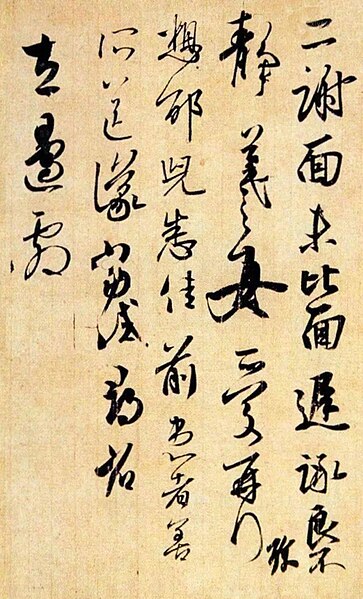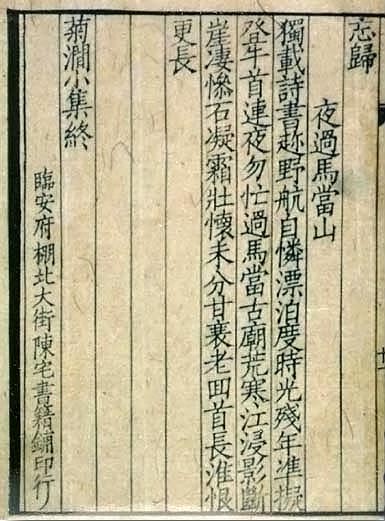Difference between revisions of "Language/Multiple-languages/Culture/Introduction-to-Han-script"
(→Idioms) |
|||
| (58 intermediate revisions by the same user not shown) | |||
| Line 251: | Line 251: | ||
https://upload.wikimedia.org/wikipedia/commons/thumb/1/1f/CJK_37_Strokes_%288%2B29%29.png/500px-CJK_37_Strokes_%288%2B29%29.png | https://upload.wikimedia.org/wikipedia/commons/thumb/1/1f/CJK_37_Strokes_%288%2B29%29.png/500px-CJK_37_Strokes_%288%2B29%29.png | ||
The character | The character 永 has all eight traditional basic strokes, so it is often used to practice calligraphy. | ||
https://upload.wikimedia.org/wikipedia/commons/thumb/c/c6/8_strokes_of_%E6%B0%B8-zh.svg/600px-8_strokes_of_%E6%B0%B8-zh.svg.png | https://upload.wikimedia.org/wikipedia/commons/thumb/c/c6/8_strokes_of_%E6%B0%B8-zh.svg/600px-8_strokes_of_%E6%B0%B8-zh.svg.png | ||
| Line 360: | Line 360: | ||
== Readings of a character == | == Readings of a character == | ||
For Chinese language, each character has phonetically and semantically identical readings; for non-Chinese languages, each character has two types of reading: one being phonetically similar to the Chinese reading [音讀], the other being the semantically corresponding native word's reading [訓讀]. | In pre-modern times, readings of characters by the officials are called the elegant pronunciations [雅音]. They were ''de facto'' standard pronunciations. | ||
For Chinese language, each character has phonetically and semantically identical readings; for non-Chinese languages, each character has two types of reading: one being phonetically similar to the Chinese reading, which is called the sound reading [音讀], the other being the semantically corresponding native word's reading, which is called the instructed reading [訓讀]. | |||
The ancient method to note readings is called reverse cutting [反切], where each character's reading is denoted by a character's initial consonant and the rest of another character's syllable. For example, the reading of 東 is denoted by the initial consonant of 德 and the rest of 紅: | The ancient method to note readings is called reverse cutting [反切], where each character's reading is denoted by a character's initial consonant and the rest of another character's syllable. For example, the reading of 東 is denoted by the initial consonant of 德 and the rest of 紅: | ||
https://upload.wikimedia.org/wikipedia/commons/thumb/a/a8/Qieyun_Dong_entry_fanqie.svg/115px-Qieyun_Dong_entry_fanqie.svg.png | https://upload.wikimedia.org/wikipedia/commons/thumb/a/a8/Qieyun_Dong_entry_fanqie.svg/115px-Qieyun_Dong_entry_fanqie.svg.png | ||
== Appellation of a character == | |||
To address a single character while differentiating it from its homophones, one may say its components first and then say the character. For example, “bow–long stretch” (弓長張) for 張. | |||
== Calligraphy == | == Calligraphy == | ||
| Line 371: | Line 376: | ||
There is a website for searching characters in calligraphy [https://sfzd.jiguzuo.com/ 集古作书法字典]. | There is a website for searching characters in calligraphy [https://sfzd.jiguzuo.com/ 集古作书法字典]. | ||
== | == Set phrases == | ||
Set phrases [成語] in Han script are mostly as short as four characters. There are Chinese | Set phrases [成語] are a kind of idiomatic expressions in Han script. They are mostly as short as four characters. There are | ||
* Chinese set phrases on [https://letstraveltochina.com/chinese-idioms/ Let's Travel To China] | |||
* Japanese set phrases on [https://imabi.org/idioms-iv-yojijukugo/ IMABI] | |||
* Korean set phrases on [http://www.koreanlii.or.kr/w/index.php/4-character_idiom KoreanLII]. | |||
For languages other than Chinese, also possible to build set phrases in the same manner. | For languages other than Chinese, it is also possible to build set phrases in the same manner. | ||
Example of popularised English idioms in Chinese set phrases: | |||
* tip of the iceberg 冰山一角 : iceberg + a + corner | |||
* kill two birds with one stone 一石二鳥 : one + stone + two + birds | |||
The following idioms in set phrases are original by the author and are not popularised yet. | |||
[[Language/Multiple-languages/Culture/idioms-in-Set-Phrases]] | |||
Latest revision as of 07:33, 22 June 2025
Hi, polyglots!
Every time you see Han characters, you may see them as random strokes and wonder how other people memorise them. Once you have payed attention for a while and learned about the basics of Han script, they will become crystal clear to you.
in progress
Evolution of Han script[edit | edit source]
There is an evolution: Egyptian → Proto-Sinaitic → Phoenician → … → most scripts used today. Han script has its own: oracle bone script [甲骨文], bronze script [金文] and other scripts → seal script [篆書] → clerical script [隸書] → regular script [楷書].
There are artistic scripts derived from the regular script:
- running script [行書] (a.k.a. semi-cursive script)
- grass script [草書] (a.k.a. cursive script)
There are also typefaces for printing:
- Song [宋體] / Ming [明體] (a.k.a. sans-serif)
- Imitation Song [仿宋體]
- Gothic [黑體] (a.k.a. sans)
Glyph forms of early scripts are highly diverse. After the unification of China by Qin dynasty, glyph forms other than the ones used in the State of Qin are abolished. In the modern time, character glyph forms are standarised differently in different sovereign states and dependent territories.
Simplifications of Han characters take place in different times. Systematic simplifications include the creation of the clerical script in the State of Qin and the Chinese Character Simplification Scheme in the People's Republic of China.
There is a website for searching characters in ancient scripts 汉字源.
| script | image |
|---|---|
| oracle bone script [甲骨文] | 
https://commons.wikimedia.org/wiki/Category:Oracle_bone_script |
| bronze script [金文] | 
|
| seal script [篆書] | 
|
| clerical script [隸書] | 
|
| regular script [楷書] | 
|
| running script [行書] | 
https://commons.wikimedia.org/wiki/Category:Semi-cursive_script |
| grass script [草書] | 
https://commons.wikimedia.org/wiki/Category:Chinese_cursive_script |
| typeface | image |
|---|---|
| Song [宋體] / Ming [明體] | 
https://commons.wikimedia.org/wiki/Category:Ming_(typefaces) |
| Imitation Song [仿宋體] | 
|
| Gothic [黑體] | 
|
Creation and use of Han characters[edit | edit source]
It is mentioned that there are six categories of characters [六書] in the Rites of Zhōu [《周禮》] without explanation. Nowadays, those six categories of characters are thought to be the following:
| category of characters | explanation of the category | example | meaning of the example | explanation of the example |
|---|---|---|---|---|
| pictographs [象形字] | a character where concrete objects are depicted in pictorial form |
|
|
|
| indicatives [指事字] | a character where abstract ideas are depicted in pictorial form |
|
|
|
| compound ideographs [會意字] | a character consisting of two or more semantic components |
|
|
|
| phono-semantic compounds [形聲字] | a character consisting of a phonetic and a semantic components |
|
|
|
| category of characters | explanation of the category | example | meaning of the example | explanation of the example |
|---|---|---|---|---|
| derivative cognates [轉注字] | characters with different readings and meanings derived from the same original character; disputed as it is unnecessary to exist |
|
|
|
| loangraphs [假借字] | a character borrows another character's shape; the character being borrowed changes its form |
|
|
|
Strokes of a character[edit | edit source]
The elementary components of characters are strokes [筆畫]. Basic strokes [基本筆畫] are
| stroke | modern name of stroke | writing direction |
|---|---|---|
| ㇐ | horizontal [橫] | 
|
| ㇑ | vertical [豎] | 
|
| ㇒ | throw [撇] | 
|
| ㇏ | press [捺] | 
|
| ㇔ | dot [點] | 
|
| ㇀ | raise [提] | 
|
| ㇚ | hook [鉤] | 
|
| ㇁ | curve [彎] | 
|
| stroke | modern name of stroke | writing direction |
|---|---|---|
| ㇄ | slant [曲] | 
|
| ㇣ | circle [圈] | 
|
A compound stroke [複合筆畫] is a stroke that is combined by multiple basic strokes. They can be defined differently by different approaches. For example:

The character 永 has all eight traditional basic strokes, so it is often used to practice calligraphy.

Components of a character[edit | edit source]
A character is made of one or more components. Those components are made of one or more strokes.
Those components are written one by one from left to right, from top to bottom, in order to make the character look good.
The components used for indexing in a dictionary are called radicals [部首]. In some cases, a character may be assigned multiple radicals. Explaining Graphs and Analyzing Characters [《說文解字》] and Kāngxī Dictionary [《康熙字典》] published in c. 100 and 1716 are two of the most authoritative dictionaries, where 540 and 214 radicals are listed.
The compositions of a characters are the followings:
| composition | common radicals |
|---|---|
| ⿰ | (many) |
| ⿱ | (many) |
| ⿲ | (many) |
| ⿳ | (many) |
| ⿴ | 囗 |
| ⿵ | 冂、几、門、鬥 |
| ⿶ | 凵 |
| ⿷ | 匚、匸 |
| ⿼ | |
| ⿸ | 厂、尸、手、广、戶、疒、羊、老 |
| ⿹ | 乙、勹、弋、气 |
| ⿺ | 大、尢、廴、⽑、⽖、⾛、瓜、辵、鬼、麥、鼠 |
| ⿽ | 水 |
| ⿻ | 木 |
| ⿾ | |
| ⿿ | |
| 〾 | |
| ㇯ |
There are also ways to pick up a type in printing quickly. After the popularisation of computers, shape-based input methods emerged. Those components of such input methods are called roots [字根].
| shape-based input method | time | layout |
|---|---|---|
| 四角 | 1925 | 
|
| 三角 | 1971 | 
|
| 倉頡 | 1976 | 
|
| 大易 | 1988 | 
|
| 嘸蝦米 | 1990 | 
|
| 行列 | 1992 | 
|
| 縱橫 | 1993 | 
|
Readings of a character[edit | edit source]
In pre-modern times, readings of characters by the officials are called the elegant pronunciations [雅音]. They were de facto standard pronunciations.
For Chinese language, each character has phonetically and semantically identical readings; for non-Chinese languages, each character has two types of reading: one being phonetically similar to the Chinese reading, which is called the sound reading [音讀], the other being the semantically corresponding native word's reading, which is called the instructed reading [訓讀].
The ancient method to note readings is called reverse cutting [反切], where each character's reading is denoted by a character's initial consonant and the rest of another character's syllable. For example, the reading of 東 is denoted by the initial consonant of 德 and the rest of 紅:

Appellation of a character[edit | edit source]
To address a single character while differentiating it from its homophones, one may say its components first and then say the character. For example, “bow–long stretch” (弓長張) for 張.
Calligraphy[edit | edit source]
There are tens of thousands of characters in Han script, and even more glyphs, in Han script. The calligraphy of it is also developed.
There is a website for searching characters in calligraphy 集古作书法字典.
Set phrases[edit | edit source]
Set phrases [成語] are a kind of idiomatic expressions in Han script. They are mostly as short as four characters. There are
- Chinese set phrases on Let's Travel To China
- Japanese set phrases on IMABI
- Korean set phrases on KoreanLII.
For languages other than Chinese, it is also possible to build set phrases in the same manner.
Example of popularised English idioms in Chinese set phrases:
- tip of the iceberg 冰山一角 : iceberg + a + corner
- kill two birds with one stone 一石二鳥 : one + stone + two + birds
The following idioms in set phrases are original by the author and are not popularised yet.